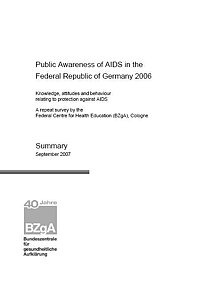Studies
The Federal Centre for Health Education endeavours to make its work as effective as possible. To achieve this goal, there is a need to constantly improve education activities and continuously review the success of the measures.
It is for this reason that we regularly conduct studies.
They make it possible
- To gear the planning and implementation of education measures in the various subject fields to the latest scientific findings,
- To examine whether our measures really do achieve the targeted, health-promoting effects.
Although the questions and the results of these studies therefore always have a direct link to the work of BZgA, they also contain a wealth of information that can be used by the interested public, and particularly by people and institutions working in the field of health prevention.
Consequently, all the studies conducted by BZgA are published.
The studies and evaluation results from the field of sex education, contraception and family planning can be found at: www.forschung.sexualaufklaerung.de
We will be more than pleased to provide further information:
Bundeszentrale für gesundheitliche Aufklärung
Referat 2-25
Ostmerheimer Strasse 220
D-51109 Köln, Germany
E-mail: forschung(at)bzga.de
See below the list of all available studies with at least an englisch short version.
The overall list of all available studies can be found here.
Public Awareness of AIDS in the Federal Republic of Germany 2006
Knowledge, attitudes and behaviour relating to protection against AIDS
A repeat survey by the Federal Centre for Health Education (BZgA), Cologne
Aids im öffentlichen Bewusstsein der Bundesrepublik Deutschland 2006
The perception of AIDS as one of the most dangerous diseases is continuing to decline. In 2006, less than one-third (29 percent) of the general population considers AIDS to be one of the most dangerous diseases (1987: 65 percent). Among 16 to 20 year-old young people, 43 percent of the respondents still rate AIDS as one of the most dangerous diseases of our time (1987: 85 percent).
The mass media and interpersonal communication about HIV and AIDS are less and less frequently named as a source of information. While almost the entire population (96 percent) came into contact with the subject of AIDS through the mass media in 1987, less than half of the population (43 percent) names them as a source of information in 2006. 16 percent talked about HIV and AIDS in private conversations in 2006 (1991: 50 percent).
AIDS education continues to reach the majority of the population. The reach of the billboards among the general public has risen slightly in the last five years. The reaches of the other mass-communication media (cinema, TV and radio spots) among the general public have declined slightly or are stagnating.
Mass-media AIDS education achieves substantially higher reaches among the target group of particular importance for prevention, i.e. young people. In 2006, the new vegetable/condom motifs were able to boost the reach of the billboards (in the three months prior to the survey) among 16 to 20 year-old young people from 78 percent in 2005 to 94 percent in 2006. In total, the proportion of 16 to 20 year-old young people in Germany who were reached by at least one of the BZgA´s mass media in the short period of the last three months now amounts to 96 percent.
Since the start of the AIDS education campaign, the knowledge of the general public, and particularly also of 16 to 20 year-old young people, regarding the transmission routes of HIV has reached a very high level that has been maintained to this day.
The use of condoms has also spread substantially in the population of the Federal Republic of Germany. In 1988, 58 percent of the sexually active group of singles under the age of 45 used condoms, the proportion in 2006 being 73 percent. The figure for regular condom use (always or often) has risen markedly in the last two years, now reaching 56 percent and thus the highest level in the whole of the period covered by the study. The percentage of singles under the age of 45 who never use condoms has remained roughly unchanged for more than ten years. In 2006, 27 percent of the respondents not having a steady partner stated that they did not use condoms during sexual intercourse.
In 2006, 84 percent of the respondents who had several sex partners in the past year used condoms. Here, the proportion of people using condoms regularly (often or always) has risen from 52 percent to 62 percent in the last three years.
For the first time since the year 2000, condom sales in 2006 again rose to what was then a record sales total of 207 million.
Attitudes towards people with HIV and AIDS again remained stable in 2006. 95 percent of the population reject the isolation of people with HIV and AIDS.

 Suche
Suche
